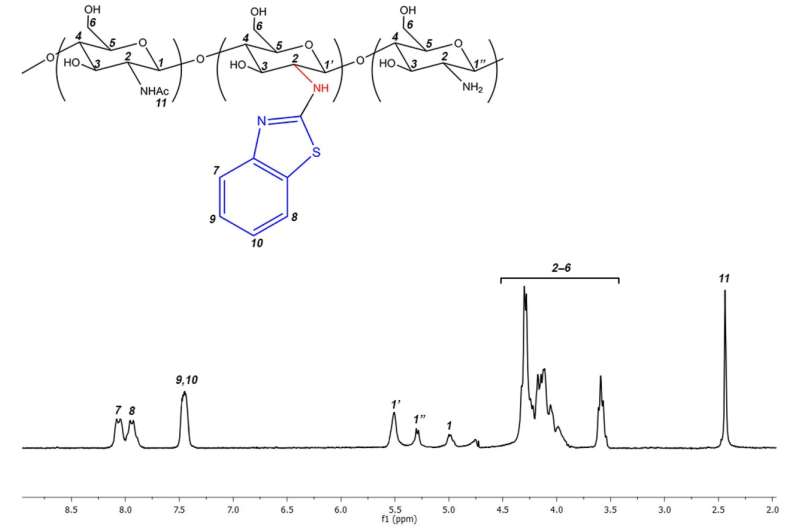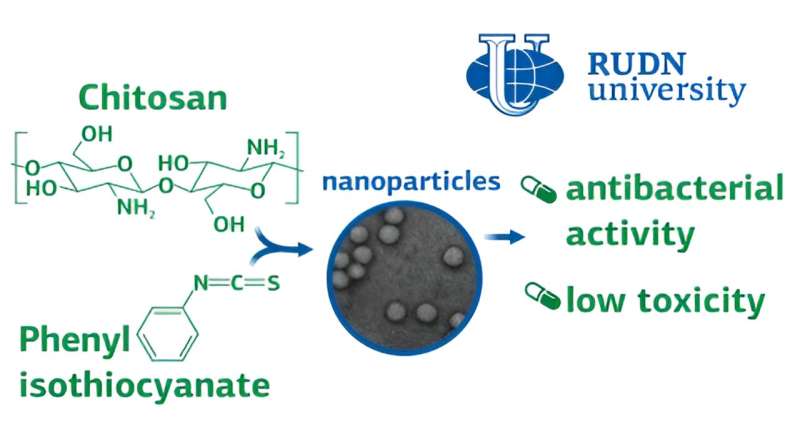This article has been reviewed according to Science X's editorial process and policies. Editors have highlighted the following attributes while ensuring the content's credibility:
fact-checked
proofread
Chemists obtain derivatives of the natural polymer chitosan, which outpace existing antibiotics

RUDN University chemists and colleagues from Belarus obtained derivatives of the natural polymer chitosan, which exceeded existing antibiotics in antibacterial activity. Moreover, the new substances are non-toxic, and the production method is safe. The results were published in Polymers.
Modern antibiotics can be too weak and cause allergies and side effects, so we need to develop new approaches to treat bacterial infections. The chemistry of polymers helps with this, including natural polymers like chitosan obtained from crab shells. Its derivatives and modified systems based on it are used for the development of antibacterial drugs.
RUDN University chemists and colleagues from Belarus proposed a new approach, combining the advantages of chitosan and the cyclic organic compound benzothiazole, which also has antibacterial properties.
"The natural polymer chitosan has inspired many researchers due to its biocompatibility, biodegradability, non-toxicity, and many other attractive biological properties, including antibacterial effects. Antibacterial derivatives have been obtained based on chitosan. On the other hand, several highly effective antibacterial low-toxic compounds have been obtained based on benzothiazole. These results inspired us to synthesize benzothiazole derivatives of chitosan and study their antibacterial properties," said Andrey Kritchenkov, Ph.D., Department of Inorganic Chemistry, RUDN University.

RUDN University chemists have combined two directions—chitosan derivatives and low-toxic antibacterial benzothiazole systems. Chemists have obtained benzothiazole derivatives of chitosan hoping that the joint antibacterial effect of chitosan and benzothiazole will be better than that of these substances individually.
To do this, the scientists used an electrochemical coupling reaction—a first for components of this kind. The authors tested the resulting antibacterial systems in vivo and in vitro. Antibacterial effectiveness was tested on gram-positive Staphylococcus aureus and gram-negative Escherichia coli.
Antibacterial systems surpassed unmodified chitosan and the well-known antibiotics ampicillin and gentamicin in their effectiveness against bacteria.
The diameter of the bacteria-affected zone in the Petri dish turned out to be only a couple of millimeters smaller than that of antibiotics, but in an in vivo model of peritonitis in rats, the new compounds reduced the number of bacteria by 10 times—to 8 viable bacteria per milliliter instead of 82 for ampicillin and gentamicin. Moreover, the toxicity of the new derivatives is practically no different from harmless natural chitosan.
"Synthesized polymers and nanoparticles based on chitosan showed high antibacterial activity and low toxicity. This suggests their potential as an effective alternative to traditional antibiotics. In the future, more in-depth studies and preclinical trials are needed to evaluate their use in clinical settings," said Anton Egorov, research intern at RUDN University.
More information: Tatsiana V. Shakola et al, Benzothiazole Derivatives of Chitosan and Their Derived Nanoparticles: Synthesis and In Vitro and In Vivo Antibacterial Effects, Polymers (2023). DOI: 10.3390/polym15163469
Provided by Russian Foundation for Basic Research





















